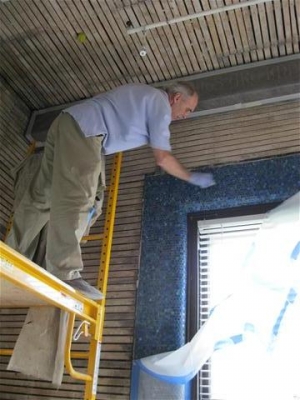|
Displaying items by tag: mosaics
Israel Antiquities Authority (IAA) yesterday unveiled a large, 1,700-year-old mosaic floor featuring intricate patterns and images of animals, uncovered in the city of Lod, about nine miles southeast of Tel Aviv. The discovery, made last year during excavations from June through November, occurred when archaeologists were preparing the site to build a visitors center to display the famous Lod Mosaic, according to a release published by the Israel Ministry of Foreign Affairs. The Lod Mosaic, which measures 600 square feet (~55 square meters) and has recently been on view in museums from the Louvre to the Metropolitan Museum of Art, served as the living room floor for the same ancient villa that housed the recently exposed work, which archaeologists believe decorated its courtyard.
After an act of 'so-called' restoration akin to the horrors of 'Ecce Homo' - a mural depicting Christ with a crown of thorns, became an internet sensation when it was disfigured by Seniora Gimenez, while she attempted to restore it. The 120-year-old fresco had been transformed into something which resembled a character from "Planet of the Apes" - according to Turkish media, the country's culture ministry is investigating reports that a number of valuable Roman mosaics were badly damaged during botched restoration at an archaeological museum.
This weekend marked the reopening of Pompeii's Villa of Mysteries after two years and €900,000 ($973,600) worth of careful restorations to the building's ancient frescoes and mosaics.
The villa is one of the best-preserved homes in Pompeii, which was buried in the ashes of the eruption of Mount Vesuvius in 79, and remained lost until its excavation in 1748. The Villa of Mysteries is best-known for its brightly-colored red and orange paintings of life-size figures, believed to depict the initiation rights of the cult of Dionysus, the wine god.
The popular exhibition "Heaven and Earth: Art of Byzantium from Greek Collections" at the Art Institute of Chicago has been extended for three months beyond its original closing date of Feb. 15, 2015. The show, which presents more than 60 superb artworks of the Byzantine era, from the 4th to the 15th centuries, will remain on view through May 10, 2015.
Organized by the Hellenic Ministry of Culture and Sports of Athens, Greece, with the collaboration of the Benaki Museum, Athens, and originally exhibited at the National Gallery of Art in Washington, D.C., and the J. Paul Getty Museum in Los Angeles, the exhibition includes major artistic holdings from Greece consisting of mosaics, sculptures, manuscripts, luxury glass, silver, personal adornments, liturgical textiles, icons, and wall paintings.
Three unique mosaics, dating to the second century BC, have been unearthed in the ancient Greek settlement of Zeugma, in southeast Turkey, according to the "Greek Reporter."
The mosaics, which were found in excellent condition, were unearthed after five years of archaeological excavations. The effort was carried out in a race against time before a large part of the site was flooded by water held back by the nearby Birecik dam.
For a picturesque ride, few railroads in New York rival Amtrak’s Empire line along the Hudson River.
The West End line on the D train, between Sunset Park and Coney Island in Brooklyn, would not seem to be among them.
What it lacks in scenery, however, it makes up in art. Twelve of the 14 stations between 36th Street and the Stillwell Avenue terminus now offer some kind of visual delight: mosaic proletarians, cast-bronze bees and a 20-foot-long translucent hot dog. (You’ll never guess where.)
When Aimé Maeght, a French art dealer, lost his young son to leukemia in the 1950s, a trio of formidable modern painters—Georges Braque, Joan Miró and Fernand Léger—persuaded him to turn the family’s summer retreat above the hills of Nice into an artists’ haven. The Marguerite and Aimé Maeght Foundation is 50 years old this month, and still bears abundant traces of the artists who made it happen: a magical Miró labyrinth, mosaics and stained glass by Braque. Its collection of 12,000 works includes 35 sculptures by Alberto Giacometti, as well as masterpieces by Pierre Bonnard, Marc Chagall, Miró, Léger and Alexander Calder, among others. On average, 200,000 visitors tour its colourful galleries and garden every year.
Behind the idyllic exterior, though, the institution is vulnerable. The foundation is finding it hard to raise its €3m ($4m) annual budget.

The Tiffany Reading room located in Irvington, New York’s Town Hall opened this month after years of restoration. Designed by Louis Comfort Tiffany, the renowned artist, decorator, and glassmaker, the Tiffany Reading Room boasts lettering gilded in gold leaf, glass mosaics, and turtleback lanterns.
Louis Tiffany (1848-1933), the son of Tiffany & Co. founder, Charles Lewis Tiffany (1812-1902), was a long-time resident of both New York City and Irvington; an affluent suburb located just 20 miles north of midtown Manhattan. Charles Tiffany served as a trustee of Irvington’s Mental and Moral Improvement Society, which donated the land on which the Town Hall was built in 1892. The Society’s only stipulation was that the building should include a free reading room for the public’s enjoyment. In keeping with this request, Helen Gould, the daughter of railroad magnate Jay Gould, donated $10,000 to have the room designed by Louis Tiffany.
Once a majestic and beautifully decorated space, the Reading Room had fallen into disrepair by the late 1990s. Inspired by a letter from Tiffany’s great-grandson, Irvington residents formed the Tiffany Room Committee and embarked on a $280,000, eight-year-long restoration. The result of their efforts is a Reading Room that has been returned to its original grandeur, featuring restored mosaics and wall sconces and tables and chairs by Tiffany Studios.
|
|
|
|
|